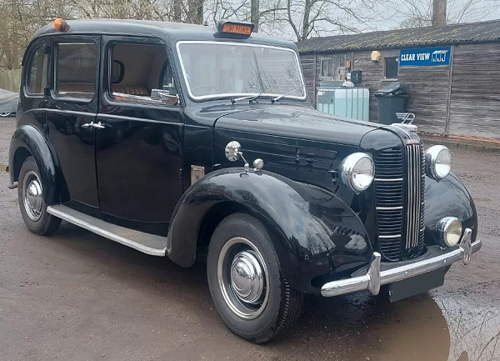Taxi! - Colin Shepherd and his Austin FX3D
07 March 2025
Think of smog. Think of Woodbines. Think of Teddy Boys. Think of cabbies who resemble Harry Fowler, Sidney James, Sam Kydd, or David Lodge, shaking their fists out of the driver’s window and shouting, “What’s your game?”. Colin Shepherd’s 1957 Austin FX3D is a taxi that belongs to this realm, including moaning about the 6d tip.

The FX3 debuted in June 1948 and was jointly developed by Austin, Carbodies of Coventry, and Mann and Overton, who held the concession for Austin taxi chassis throughout London. Taxi operators also had an input into the design, and the FX3 has a box-section steel chassis and all-leaf suspension. Power was from the Austin A70 Hampshire’s 2,199cc ‘Big Four’ engine married to a four-speed gearbox, which was thought better suited than a three-speed transmission for London’s road conditions.

The latest London taxi had an opening windscreen - for demisting and negotiating fogs when driving along the Embankment, a hydraulic ‘Jackall’ jacking system controlled from the dashboard, “best quality” hide upholstery, a height-adjustable driver’s seat with a toolbox underneath, a fog light, a locker mounted on the nearside running board, a tinted rear screen and a spring-loaded ‘quick release’ driver’s window.
A heater was an optional extra, although the passengers benefitted from an air vent above the central division. The sealed driver’s compartment was a fitting welcomed by many drivers, while the FX3 was to be the final London taxi with three doors and an open luggage compartment.
The Austin FX3 also had mechanical rod-operated Girling brakes as the Public Carriage Office (PCO) was unkeen on a hydraulic set-up. The FX3 had to comply with their ‘Conditions of Fitness’, which demanded a maximum turning circle of 25 feet and a chassis clearance of at least 10 inches. Furthermore, gentlemen should be able “to travel comfortably in top hats,” and there was no under-bonnet sound deadening; the PCO thought it was a potential fire hazard.

Some drivers were initially wary of the FX3, for at £936 1s 8d, it cost virtually twice as much as the pre-war Austin Heavy Twelve-Four-based taxi. Danny Roth explains in his fascinating book Where to, Guv?: The Complete History of the British Taxi Service that “only about 130 new cabs were licensed in 1952”. In addition:
The FX3 had embarrassingly high fuel consumption, hitting fleet proprietors. Worse still, drivers, dissatisfied with their modest share of fares, struck, being rewarded with an increase in their meter fare share from a quarter to three-eighths.
However, the 1953 budget accepted the complete abolition of Purchase Tax “on police-approved vehicles, reducing the FX3’s price from £1,100 to £834”. The Austin taxi’s popularity was further improved in 1954 with the introduction of the 2.2-litre diesel-engine FX3D. By 1955 Roth points out “one-third of London’s taxis were diesel powered. With petrol costing 4s 11/2d (20.4p) per gallon, diesel buyers saved about 10 per cent”.

That same year, Austin taxis had roof-mounted flashing ‘bunny ear’ flashing indicators rather than trafficators. Owners of older FX3s found that punters often used the semaphore trafficator arms as unofficial grab handles on leaving the cab. The FX4 replaced the FX3 1958 after 12,435 units, with 7,267 plying for hire in London. They remained in service in the capital until 1968, but this was not quite the end of the narrative as into the early 1970s some towns still favoured the FX3.
Colin acquired his last-of-the-line FX3D when one of his friends sold his wedding car business. After three months of fettling, it was once ready for the highway, including LED bulbs fitted to the indicators for extra visibility. Today, the FX3D appears to have emerged from a black-and-white film commencing with ‘Nat Cohen and Stuart Levy Present’.
And as one advertisement boasted: “You see more Austin taxis on the streets of London than any other single make of cab”.
With thanks to Colin Shepherd for his time and permission to use the images in this blog.
